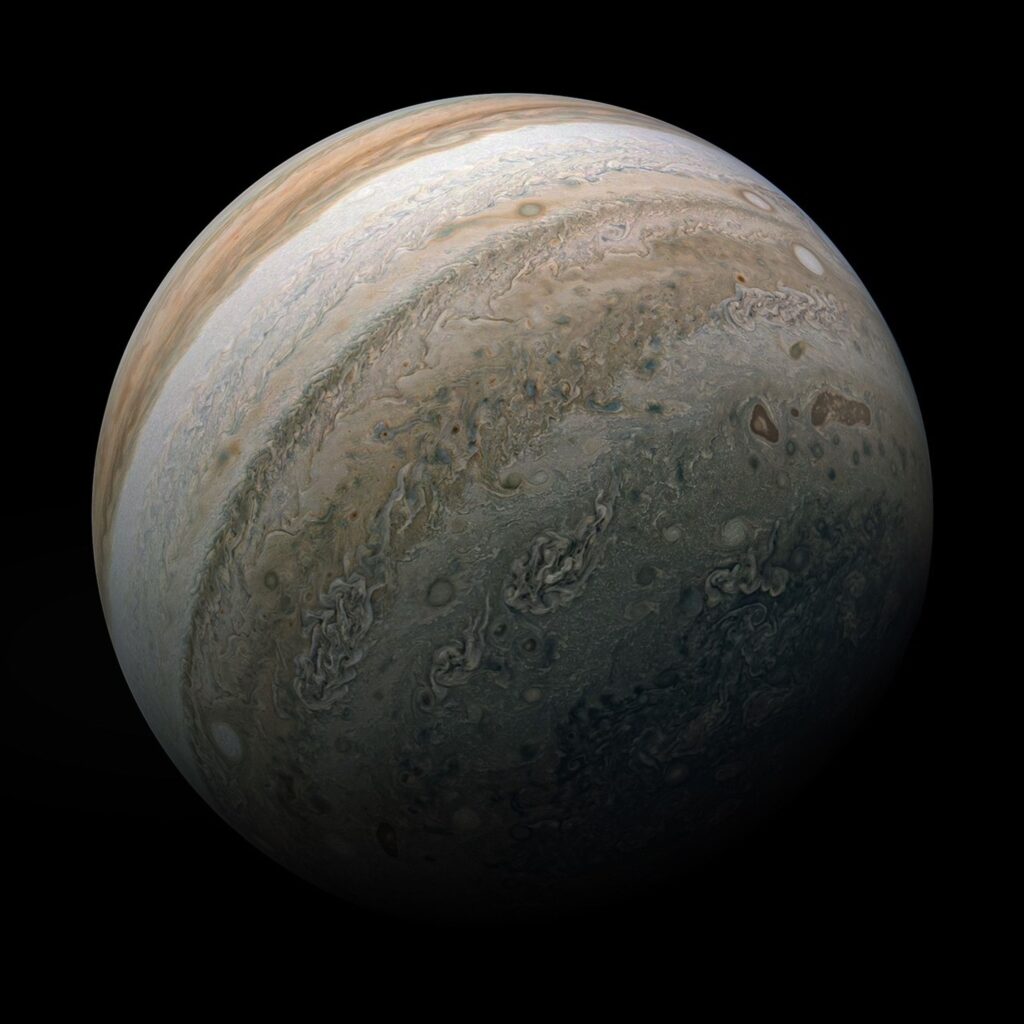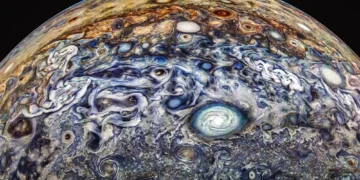Jupiter, the largest planet in our solar system, has intrigued humanity for centuries with its swirling storms and colossal size. But one question continues to baffle and fascinate: How can a planet so massive lack a solid surface? As NASA’s Juno probe orbits this gas giant, unraveling its mysteries, let’s dive into the science behind Jupiter’s unique composition, its critical role in our solar system, and what its study means for our understanding of planetary science.
A Planet Unlike Any Other
Jupiter is a gas giant, a category of planets vastly different from the rocky worlds of Mercury, Venus, Earth, and Mars. Unlike Earth, which has a solid crust to walk on, Jupiter is composed almost entirely of hydrogen and helium, resembling the Sun in its makeup. Its immense mass, over two and a half times that of all the other planets combined, allows it to hold together as a cohesive sphere despite lacking a solid foundation.
This distinction raises a fundamental question: If there’s no surface, what lies beneath its chaotic clouds? The answer lies in Jupiter’s layered composition, where gas transitions into exotic states of matter under immense pressure and heat.
Peeling Back the Layers of Jupiter

Enhanced image by Kevin M. Gill (CC-BY) based on images provided courtesy of NASA/JPL-Caltech/SwRI/MSSS
The Gaseous Atmosphere
Jupiter’s outermost layer is a thick atmosphere of hydrogen and helium, whipped into dynamic motion by ferocious winds that can exceed 400 miles per hour. These atmospheric dynamics give rise to iconic features like the Great Red Spot, a centuries-old storm larger than Earth. While this outer layer appears chaotic, it plays a vital role in shaping the planet’s overall structure.
The Transition to Liquid Hydrogen
Beneath the gaseous layer, the pressure intensifies, compressing the hydrogen into a liquid state. This layer forms the largest “ocean” in the solar system—not of water, but of liquid hydrogen. The gradual transition from gas to liquid creates a dense, turbulent environment unlike anything found on Earth.
Metallic Hydrogen: A Cosmic Rarity
As the pressure and temperature continue to rise, the hydrogen becomes metallic—a state where electrons flow freely, turning hydrogen into a conductive material. This metallic hydrogen layer generates Jupiter’s powerful magnetic field, which is 20,000 times stronger than Earth’s.
The Core: Science’s Final Frontier
At Jupiter’s heart lies a core of uncertain composition. Some scientists believe it to be a dense mixture of rock and metal, while others argue it may be a diffuse, molten state. With pressures 100 million times that of Earth’s atmosphere and temperatures reaching 35,000 degrees Fahrenheit, studying Jupiter’s core remains one of the most significant challenges in planetary science.
Why Does Jupiter Look Like It Has a Surface?
The illusion of a surface stems from the visible cloud tops, where storms and belts of gas form intricate patterns. These clouds reflect sunlight, giving Jupiter its iconic appearance. However, beneath these clouds lies a continuous gradient of gas and liquid, with no definitive boundary.
Space missions like NASA’s Juno probe have provided unprecedented insights into Jupiter’s atmospheric depth, revealing that its storms and jet streams extend far deeper than previously thought. This understanding helps demystify the gas giant’s deceptive appearance.
Jupiter’s Role as the Solar System’s Protector
Jupiter’s immense gravitational pull makes it a cosmic guardian for the inner planets, including Earth. By deflecting or capturing asteroids and comets, Jupiter reduces the likelihood of catastrophic impacts. This protective role has likely been crucial for the development and sustenance of life on Earth.
One famous example of Jupiter’s protective power occurred in 1994, when the comet Shoemaker-Levy 9 collided with the planet. The massive explosions, visible even from Earth, demonstrated how Jupiter shields the solar system from potential disasters.
What Jupiter Teaches Us About Planetary Science
Studying Jupiter is not just about understanding one planet—it’s about unlocking the secrets of planetary formation and evolution. As a gas giant, Jupiter serves as a model for understanding similar planets in other star systems. Its composition and behavior provide clues about the early solar system, where gas giants likely played a pivotal role in shaping planetary orbits and conditions.
Fascinating Facts About Jupiter
- Jupiter is so massive that it influences the orbits of its moons and even other planets.
- A day on Jupiter lasts only 10 hours, making it the fastest-spinning planet in the solar system.
- Despite its size, Jupiter has a low density, with most of its mass concentrated in its hydrogen and helium layers.
The Future of Jupiter Exploration
NASA’s Juno mission continues to revolutionize our understanding of Jupiter. By measuring its magnetic fields, gravity, and atmospheric dynamics, Juno has provided critical data about the planet’s internal structure and composition. Future missions may focus on exploring its moons or even attempting to study its core more directly.
Conclusion: Jupiter’s Endless Mysteries
Jupiter stands as a testament to the diversity and complexity of our solar system. Its lack of a surface challenges our understanding of what a planet can be, while its role as a protector and its potential for harboring life on its moons make it a subject of endless fascination. As humanity continues to explore the gas giant, we are reminded of the vastness and wonder of the universe—and the countless secrets still waiting to be discovered.

















